System Info
Open the System Info screen under the RPM Help menu to see details about your RPM license and installation. With RPM Onsite licenses, the information is needed when installing upgrades, moving RPM, or creating backups. We may also ask for the information on this screen when you request technical support.

There are three different RPM license types: RPM Cloud, RPM Onsite with Access, and RPM Onsite with SQL Server.
An RPM Cloud license will display “Cloud License” to the right of the Client ID.
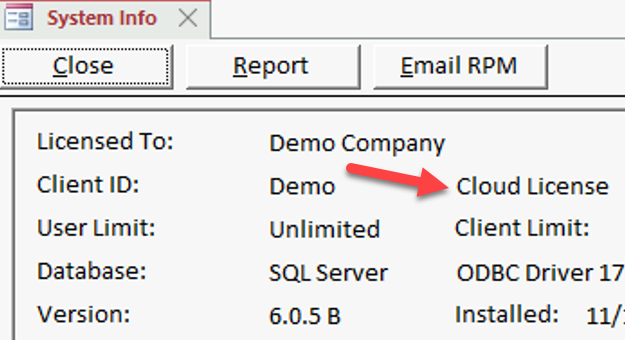
RPM Onsite licenses will NOT display “Cloud License” next to the Client ID. “Access” or “SQL Server” will be displayed in the Database.
RPM Onsite license with Access.
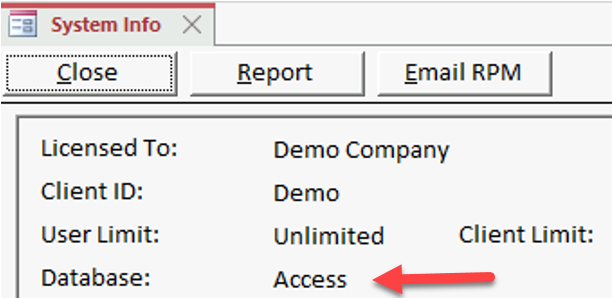
RPM Onsite license with SQL Server.
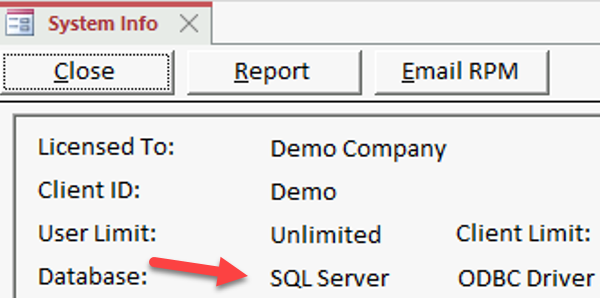
RPM Cloud
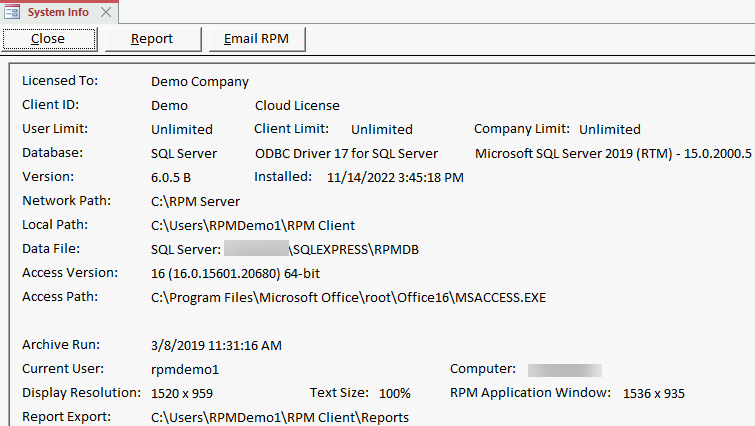
With RPM Cloud, RPM staff handle all backups and upgrades. The database and location details are not needed. Information you might use is listed below.
- License To: the license company name. This name will print on the bottom of all reports.
- Client ID: the client ID. Please provide this when requesting support.
- User Limit: unlimited.
- Client Limit: unlimited.
- Company Limit: unlimited.
- Version: the current installed version.
- Archive Run: the date and time when transactions were last archived. See Transaction archiving for more details.
- Current User: the current user ID.
- Display Resolution and Text Size: the current display resolution and text size. RPM requires a minimum resolution of 1366 x 768 with 100% text size. Larger resolutions can support a larger text size.
- RPM Application Window: the size of the RPM application window within the display.
- Report Export: the location of report export files for the current user.
RPM Onsite with Access
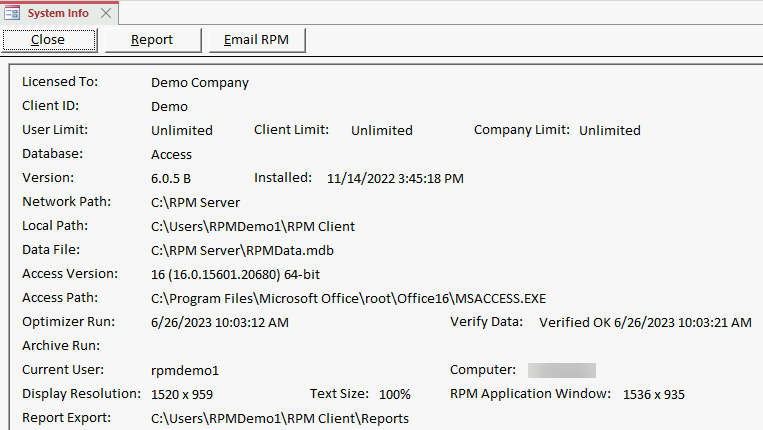
- License To: the license company name. This name will print on the bottom of all reports.
- Client ID: the client ID. Please provide this when requesting support.
- User Limit: the number of users that can log in to RPM at the same time.
- Client Limit: the number of active clients allowed. This is unlimited for all licenses other than RPM Lite.
- Company Limit: the number of company databases that can be created. More than one company is only available with a Multi-Company license.
- Database: Access.
- Version: the current installed version.
- Network Path: location of the RPM server files. This entire folder should be included in any network backups.
- Local Path: location of the RPM Client files for the current user.
- Data File: location of the main RPM data file for the current company.
- Access Version: the Access runtime version used on this computer.
- Access Path: location of the Access runtime file.
- Optimizer: the date and time the Optimizer was last run. We recommend running this on a regular basis (weekly or monthly) when using an RPM Onsite license with Access.
- Archive Run: the date and time when transactions were last archived. See Transaction archiving for more details.
- Current User: the current user ID.
- Computer: the current computer running the RPM Client.
- Display Resolution and Text Size: the current display resolution and text size. RPM requires a minimum resolution of 1366 x 768 with 100% text size. Larger resolutions can support a larger text size.
- RPM Application Window: the size of the RPM application window within the display.
- Report Export: the location of report export files for the current user.
RPM Onsite with SQL Server
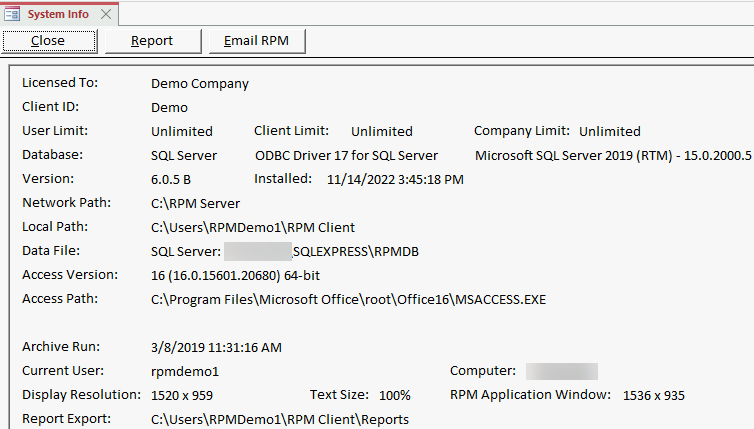
- License To: the license company name. This name will print on the bottom of all reports.
- Client ID: the client ID. Please provide this when requesting support.
- User Limit: the number of users that can log in to RPM at the same time.
- Client Limit: all RPM Onsite licenses with SQL Server allow unlimited clients.
- Company Limit: the number of company databases that can be created. More than one company is only available with a Multi-Company license.
- Database: SQL Server. The current ODBC driver used by RPM will be displayed following the database. This ODBC driver must be installed on ALL RPM Client computers. The current SQL Server version is also displayed.
- Version: the current installed version.
- Network Path: location of the RPM server files. This entire folder should be included in any network backups.
- Local Path: location of the RPM Client files for the current user.
- Data File: the SQL Server database for the current company.
- Access Version: the Access runtime version used on this computer.
- Access Path: location of the Access runtime file.
- Archive Run: the date and time when transactions were last archived. See Transaction archiving for more details.
- Current User: the current user ID.
- Computer: the current computer running the RPM Client.
- Display Resolution and Text Size: the current display resolution and text size. RPM requires a minimum resolution of 1366 x 768 with 100% text size. Larger resolutions can support a larger text size.
- RPM Application Window: the size of the RPM application window within the display.
- Report Export: the location of report export files for the current user.
